Index to Trees & Shrubs in the Order Laminales
Family Acanthaceae
669. Avicennia marina White Mangrove viewtopic.php?p=296640#p296640
Family: Bignoniaceae (Jacaranda Family)
678. Kigelia africana Sausage Tree viewtopic.php?f=248&t=3763&p=171519#p171519
673.5 Podranea ricasoliana Port St Johns Creeper viewtopic.php?p=262044#p262044
676.1 Rhigozum trichotomum Three Thorn, Kalahari Soap Bush viewtopic.php?f=248&p=171520#p171520
X985. Spathodea campanulata African Flame Tree viewtopic.php?p=204680#p204680
673.1 Tecomaria capensis Cape Honeysuckle viewtopic.php?f=248&t=3763&p=171521#p171521
Family: Lamiaceae (Sage or Mint Family)
668. Karomia speciosa Southern Chinese Hats, Wild Parasol Flower viewtopic.php?p=488827#p488827
Family: Oleaceae (Olive Family)
617. Olea europaea africana Wild Olive viewtopic.php?p=222840#p222840
Africa Wild Tree & Shrub Book - Order Laminales
Moderator: Klipspringer
Re: Africa Wild Tree & Shrub Book - Order Laminales
678. Sausage Tree Kigelia africana (Worsboom)
Order: Lamiales. Family: Bignoniaceae
 ©Toko
©Toko
Kruger National Park
 © Toko
© Toko
Pretoriuskop, Kruger National Park
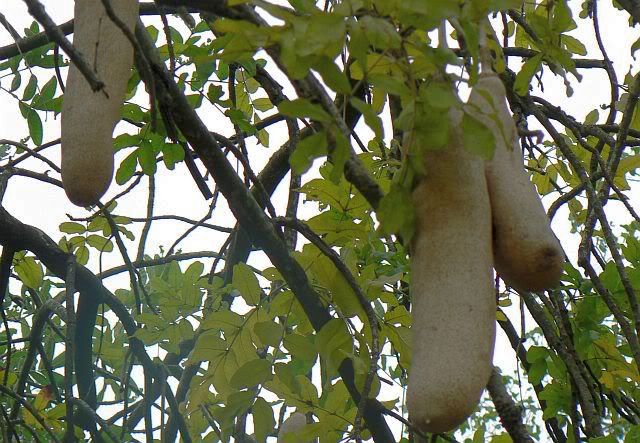
Lower Sabie, Kruger National Park


Description
The tree grows up to 20 m tall. The bark is grey and smooth at first, peeling on older trees. It can be as thick as 6 mm on a 15-cm branch. The wood is pale brown or yellowish, undifferentiated and not prone to cracking.
The tree is evergreen where rainfall occurs throughout the year, but deciduous where there is a long dry season. The leaves are opposite or in whorls of three. The flowers (and later the fruit) hang down from branches on long flexible stems (2-6 m long). Flowers are bell-shaped, orange to reddish or purplish green, and about 10 cm wide. The fruit is a woody berry from 30–100 cm long and up to 18 cm broad; it weighs between 5–10 kg, and hangs down on long, rope-like peduncles. The fruit pulp is fibrous and pulpy, and contains numerous seeds. It is eaten by several species of mammals,
Distribution
Throughout tropical Africa, from Eritrea and Chad, south to northern South Africa, and west to Senegal and Namibia. Provincial distribution in South Africa: Gauteng, KwaZulu-Natal, Limpopo, Mpumalanga; t is an eastern species running in a northward direction from Durban, up through KwaZulu-Natal, and the Lowveld and into the north-eastern Bushveld.
Habitat
The Sausage-tree is essentially moisture–loving and occurs on riverbakns and along streams, on termite mounds and in areas of higher rainfall, it ocurs also in open woodland.
Links: PlantZAfrica; Ernst Schmidt, Mervyn Lötter, Warren McCleland: Trees and Shrubs of Mpumalanga and Kruger National Park; Wild About Trees
Order: Lamiales. Family: Bignoniaceae
 ©Toko
©TokoKruger National Park
 © Toko
© TokoPretoriuskop, Kruger National Park

Lower Sabie, Kruger National Park


Description
The tree grows up to 20 m tall. The bark is grey and smooth at first, peeling on older trees. It can be as thick as 6 mm on a 15-cm branch. The wood is pale brown or yellowish, undifferentiated and not prone to cracking.
The tree is evergreen where rainfall occurs throughout the year, but deciduous where there is a long dry season. The leaves are opposite or in whorls of three. The flowers (and later the fruit) hang down from branches on long flexible stems (2-6 m long). Flowers are bell-shaped, orange to reddish or purplish green, and about 10 cm wide. The fruit is a woody berry from 30–100 cm long and up to 18 cm broad; it weighs between 5–10 kg, and hangs down on long, rope-like peduncles. The fruit pulp is fibrous and pulpy, and contains numerous seeds. It is eaten by several species of mammals,
Distribution
Throughout tropical Africa, from Eritrea and Chad, south to northern South Africa, and west to Senegal and Namibia. Provincial distribution in South Africa: Gauteng, KwaZulu-Natal, Limpopo, Mpumalanga; t is an eastern species running in a northward direction from Durban, up through KwaZulu-Natal, and the Lowveld and into the north-eastern Bushveld.
Habitat
The Sausage-tree is essentially moisture–loving and occurs on riverbakns and along streams, on termite mounds and in areas of higher rainfall, it ocurs also in open woodland.
Links: PlantZAfrica; Ernst Schmidt, Mervyn Lötter, Warren McCleland: Trees and Shrubs of Mpumalanga and Kruger National Park; Wild About Trees
- Mel
- Global Moderator
- Posts: 26737
- Joined: Sat May 19, 2012 12:31 pm
- Country: Germany
- Location: Föhr
- Contact:
Re: Africa Wild Tree & Shrub Book - Order Laminales
676.1 Three Thorn, Pale Rhigozum, Kalahari Soap Bush Rhigozum trichotomum (Driedoring)
Order: Lamiales. Family: Bignoniaceae
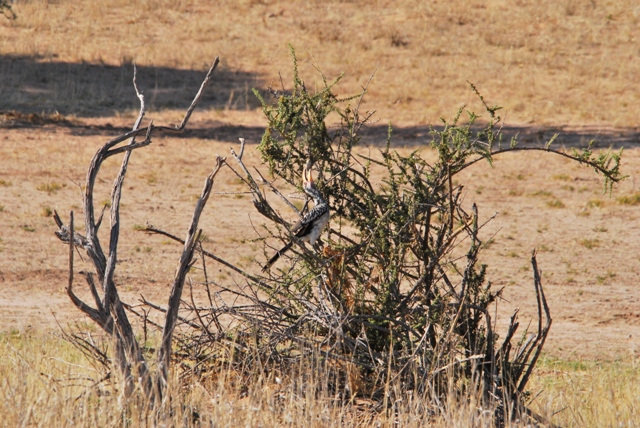
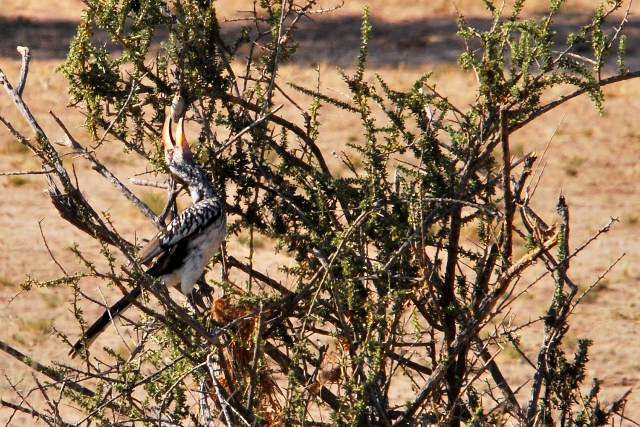
Kgalagadi Transfrontier Park (Dalkeith), Northern Cape
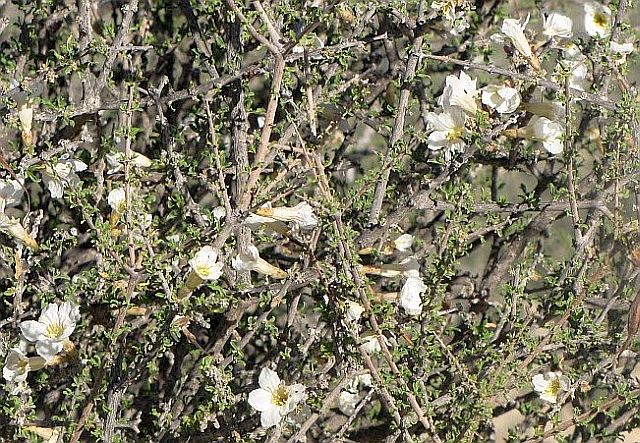 © Lisbeth
© Lisbeth
 © Lisbeth
© Lisbeth
Kgalagadi Transfrontier Park, Northern Cape
 © nan
© nan
Kgalagadi Transfrontier Park, Northern Cape
 © nan
© nan
Fruit capsules
Description
A deciduous, rigid, woody shrub, 1-2 m tall, with stems typically branching in threes and terminating in spine-like tips. Grey bark, simple leaves, spirally arranged or clustered on dwarf shoots, oblong-spathulate, dark-green, often glandular or sticky-looking, margin waxy, apex blunt and slightly recurved, petiole mostly absent. Flowers solitary, trumpet-shaped, showy, white or flushed pale pink. Fruit is a dry, papery capsule that splits early. It is a hardy species, rarely killed by intensive browsing or drought. Mismanagement and overgrazing initiate the multiplication of this species in areas which would otherwise be denuded of vegetation. In these situations it ensures a plant cover which protects the soil from wind and water erosion, provides sheltered sites for the establishment of seedlings and provides a reserve fodder bank in times of drought. Young roots are chewed for diarrhoea. Flowers September to April, fruit every few months but never many, leaves January to August with fresh leaves from September to January.
Distribution
Indigenous to the arid western regions of southern Africa in Botswana, Namibia and Eastern Cape, Free State, Northern Cape, Western Cape of South Africa.
Habitat
Prefers sandy and calcareous soils on plains, dune valleys and near pans and dry rivers.
Links: Treeatlas Biodiversity, Ecocrop; Braam Van Wyk: A Photographic Guide to Wild Flowers of South Africa
Order: Lamiales. Family: Bignoniaceae


Kgalagadi Transfrontier Park (Dalkeith), Northern Cape
 © Lisbeth
© Lisbeth © Lisbeth
© LisbethKgalagadi Transfrontier Park, Northern Cape
 © nan
© nanKgalagadi Transfrontier Park, Northern Cape
 © nan
© nanFruit capsules
Description
A deciduous, rigid, woody shrub, 1-2 m tall, with stems typically branching in threes and terminating in spine-like tips. Grey bark, simple leaves, spirally arranged or clustered on dwarf shoots, oblong-spathulate, dark-green, often glandular or sticky-looking, margin waxy, apex blunt and slightly recurved, petiole mostly absent. Flowers solitary, trumpet-shaped, showy, white or flushed pale pink. Fruit is a dry, papery capsule that splits early. It is a hardy species, rarely killed by intensive browsing or drought. Mismanagement and overgrazing initiate the multiplication of this species in areas which would otherwise be denuded of vegetation. In these situations it ensures a plant cover which protects the soil from wind and water erosion, provides sheltered sites for the establishment of seedlings and provides a reserve fodder bank in times of drought. Young roots are chewed for diarrhoea. Flowers September to April, fruit every few months but never many, leaves January to August with fresh leaves from September to January.
Distribution
Indigenous to the arid western regions of southern Africa in Botswana, Namibia and Eastern Cape, Free State, Northern Cape, Western Cape of South Africa.
Habitat
Prefers sandy and calcareous soils on plains, dune valleys and near pans and dry rivers.
Links: Treeatlas Biodiversity, Ecocrop; Braam Van Wyk: A Photographic Guide to Wild Flowers of South Africa
God put me on earth to accomplish a certain amount of things. Right now I'm so far behind that I'll never die.
Re: Africa Wild Tree & Shrub Book - Order Laminales
673.1 Cape Honeysuckle Tecomaria capensis (Kaapse Kanferfoelie, Trompetters)
Order: Laminales. Family: Bignoniaceae
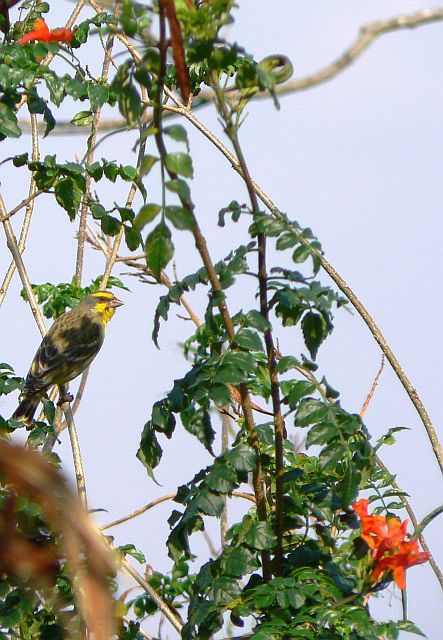
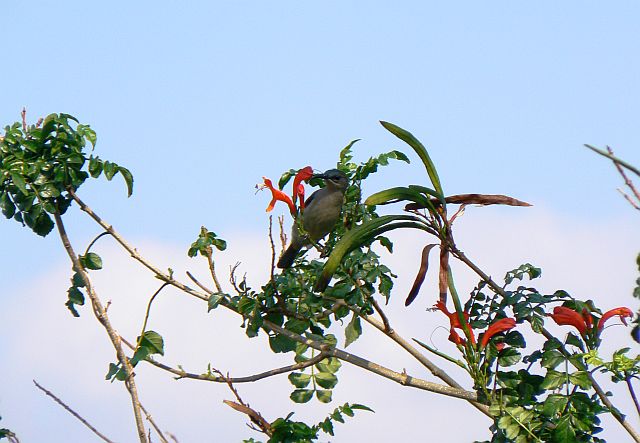
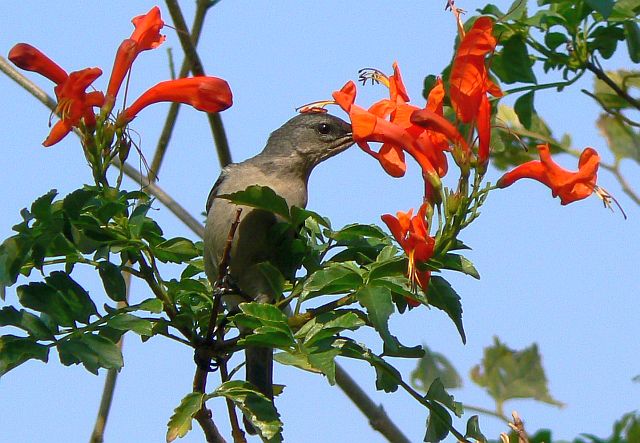
Hluhluwe Game Reserve, Hilltop (KwaZulu-Natal)
 © mposthumus
© mposthumus
Kruger National Park, Pretoriuskop Camp
Description
An erect, evergreen, scrambling shrub, it grows to 2–3 m in height and a similar width. Bark pale brown, lenticelled with longitudinal furrows on
old stems.
The leaves are opposite, slightly serrated, up to 15 cm long. They are dark glossy green, unevenly compound, usually about 3 pairs of leaflets, terminal leaflet largest. The rachis (the stalk to which the leaflets are attached) and the petiole (leaf stalk) are slightly winged (flattened).The leaflets are variable in shape, elliptic to almost round, with scalloped margins.
The flowers are tubular, narrow, on widening to a 5 lobed, 2 lipped mouth, about 7.5 cm long, and are produced at different times throughout the year. They are grouped in 10–15 cm long dense terminal clusters. The flower colour ranges from orange to orange-red to apricot.
The fruit is a long and narrow, flattened pod-like capsule, green to brown, up to 13 cm long. The capsule split lengthwise when ripe, releasing the papery winged seeds.
Distribution:
This shrub is widely distributed throughout Northern Province, Mpumalanga, Swaziland, Lesotho, KwaZulu-Natal, Cape coast and Mozambique.
Habitat
Tecoma capensis is found along drainage lines in dense decidous woodland and on forest margins. Common shrub in gardens.
Links: Braam Van Wyk, Piet Van Wyk: How to Identify Trees in Southern Africa
Order: Laminales. Family: Bignoniaceae



Hluhluwe Game Reserve, Hilltop (KwaZulu-Natal)
 © mposthumus
© mposthumusKruger National Park, Pretoriuskop Camp
Description
An erect, evergreen, scrambling shrub, it grows to 2–3 m in height and a similar width. Bark pale brown, lenticelled with longitudinal furrows on
old stems.
The leaves are opposite, slightly serrated, up to 15 cm long. They are dark glossy green, unevenly compound, usually about 3 pairs of leaflets, terminal leaflet largest. The rachis (the stalk to which the leaflets are attached) and the petiole (leaf stalk) are slightly winged (flattened).The leaflets are variable in shape, elliptic to almost round, with scalloped margins.
The flowers are tubular, narrow, on widening to a 5 lobed, 2 lipped mouth, about 7.5 cm long, and are produced at different times throughout the year. They are grouped in 10–15 cm long dense terminal clusters. The flower colour ranges from orange to orange-red to apricot.
The fruit is a long and narrow, flattened pod-like capsule, green to brown, up to 13 cm long. The capsule split lengthwise when ripe, releasing the papery winged seeds.
Distribution:
This shrub is widely distributed throughout Northern Province, Mpumalanga, Swaziland, Lesotho, KwaZulu-Natal, Cape coast and Mozambique.
Habitat
Tecoma capensis is found along drainage lines in dense decidous woodland and on forest margins. Common shrub in gardens.
Links: Braam Van Wyk, Piet Van Wyk: How to Identify Trees in Southern Africa
Re: Africa Wild Tree & Shrub Book - Order Laminales
X985. African Flame Tree, African Tulip Tree Spathodea campanulata (Afrikaanse Vlamboom)
Order: Laminales. Family: Bignoniaceae
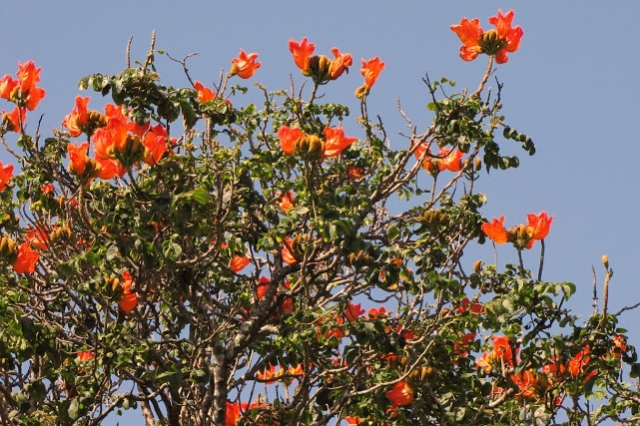 © Lisbeth
© Lisbeth
 © Lisbeth
© Lisbeth
Cape Town
Description
Medium sized, reaching a height of 10-35 m, deciduous, with a round, heavy crown of dense, dark foliage, sometimes somewhat flattened; young bark pale, grey-brown and smooth but turns grey-black, scaly and cracked vertically and horizontally with age.
The opposite imparipinnate leaves are exstipulate. Each leaf consists of 5-7 pairs of opposite leaflets and a terminal one. The leaflets are oblong-elliptic, about 1 cm long and 0.5 cm broad, entire, broadly acuminate, unequal at the base, dark green on top and light green on the underside; there are glandular swellings at the base of the lamina (usually a pair); the midrib and nerves are yellow, raised and very slightly pubescent; the venation is reticulate; the short, thick petiole is about 0.7 cm long; there
are conspicuous lenticels on the rachis; rachis base is swollen.
Flowers large, red, hermaphrodite, orange inside; calyx green, about 1 cm long and split on the posterior side, ribbed and tomentellous; petals 5, each about 1.5 cm long; stamens 4 with orange filaments; style extruding with a 2-lipped stigma; flower buds curved and contain a red sap.
Fruit upstanding, dark brown, cigar-shaped, woody pod, 15-25 cm long and split on the ground into 2 boat-shaped valves, releasing many flat-winged seedss; 1-4 pods usually develop from 1 flower cluster; seeds thin, flat and surrounded by a filmy wing.
Distribution
It is native to tropical dry forests of Africa. It has been nominated as among 100 of the "World's Worst" invaders. Native to: Angola, Ethiopia, Ghana, Kenya, Sudan, Tanzania, Uganda, Zambia.
Order: Laminales. Family: Bignoniaceae
 © Lisbeth
© Lisbeth © Lisbeth
© LisbethCape Town
Description
Medium sized, reaching a height of 10-35 m, deciduous, with a round, heavy crown of dense, dark foliage, sometimes somewhat flattened; young bark pale, grey-brown and smooth but turns grey-black, scaly and cracked vertically and horizontally with age.
The opposite imparipinnate leaves are exstipulate. Each leaf consists of 5-7 pairs of opposite leaflets and a terminal one. The leaflets are oblong-elliptic, about 1 cm long and 0.5 cm broad, entire, broadly acuminate, unequal at the base, dark green on top and light green on the underside; there are glandular swellings at the base of the lamina (usually a pair); the midrib and nerves are yellow, raised and very slightly pubescent; the venation is reticulate; the short, thick petiole is about 0.7 cm long; there
are conspicuous lenticels on the rachis; rachis base is swollen.
Flowers large, red, hermaphrodite, orange inside; calyx green, about 1 cm long and split on the posterior side, ribbed and tomentellous; petals 5, each about 1.5 cm long; stamens 4 with orange filaments; style extruding with a 2-lipped stigma; flower buds curved and contain a red sap.
Fruit upstanding, dark brown, cigar-shaped, woody pod, 15-25 cm long and split on the ground into 2 boat-shaped valves, releasing many flat-winged seedss; 1-4 pods usually develop from 1 flower cluster; seeds thin, flat and surrounded by a filmy wing.
Distribution
It is native to tropical dry forests of Africa. It has been nominated as among 100 of the "World's Worst" invaders. Native to: Angola, Ethiopia, Ghana, Kenya, Sudan, Tanzania, Uganda, Zambia.
Re: Africa Wild Tree & Shrub Book - Order Laminales
617. Wild Olive Olea europaea africana (Olienhout)
Order: Lamiales. Family: Oleaceae


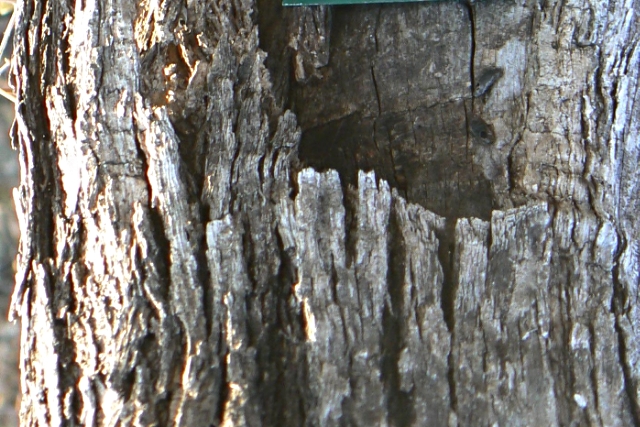
Pilanesberg
Description
The Wild Olive grows as a single stemmed tree branching out quite low down on the trunk giving the tree an almost fan-like look with the branches “fanning” out from the lower part of the tree. It has a dense and round-shaped canopy. It can look a bit weather-worn and less dense if it is growing in very windy areas and would be a smaller size all round if growing in a more exposed area like an open rocky ridge. The bark is a smooth greyish-brown on the young branches and when the trees are more mature the bark becomes rough and vertically fissured, sometimes peeling off in strips or block-shaped pieces. If you look closely at the small twigs you will see small raised dots on the bark. Sprays of tiny flowers (October to February) are followed (March to July) by small fleshy fruits.
Leaves are a shiny grey-green colour with the undersurface being green or yellowish brown. Leaves are simple with a rectangular to elliptical shape, entire, with recurved margins. They have a hooked tip and are opposite, growing from 6-10 cm long and 10-25 mm wide. The petiole (leaf stalk) is 10mm long.
Small green-cream, privet-like flowers which bloom in late spring to summer. The flowers occur in axillary panicles that are shorter than the leaves. The calyx (the sepals of one flower collectively) is 4 lobed and 1mm long and the corolla (the petals of a flower collectively) is greenish white or cream and is 1-2 mm long. The fruit is a round drupe with a sharp tip at the end. The fruit is usually 15-25 mm long and 6mm in diameter, fleshy and glaucous (dull blue-green in colour with a whitish bloom which can often be rubbed off). When mature the fruit is black to dark purple. The seed is brown, oblong and is 1 to 1.5 cm long and oily.
Distribution
Ssp. africana is the only subspecis that ocurs south of the Zambezi River in South Africa (Eastern Cape, Free State, Gauteng, KwaZulu-Natal, Limpopo, Mpumalanga, Northern Cape, North West, Western Cape), Mozambique, Swaziland, Zimbawe.
Habitat
In a variety of habitas, usually near water, on stream banks, in riverine fringes, but also in open woodland, among rocks and in mountain ravines.
Links: PlantZAfrica; Rina Grant, Val Thomas: Sappi Tree Spotting: Highlands: Highveld, Drakensberg, Eastern Cape Mountains
Order: Lamiales. Family: Oleaceae



Pilanesberg
Description
The Wild Olive grows as a single stemmed tree branching out quite low down on the trunk giving the tree an almost fan-like look with the branches “fanning” out from the lower part of the tree. It has a dense and round-shaped canopy. It can look a bit weather-worn and less dense if it is growing in very windy areas and would be a smaller size all round if growing in a more exposed area like an open rocky ridge. The bark is a smooth greyish-brown on the young branches and when the trees are more mature the bark becomes rough and vertically fissured, sometimes peeling off in strips or block-shaped pieces. If you look closely at the small twigs you will see small raised dots on the bark. Sprays of tiny flowers (October to February) are followed (March to July) by small fleshy fruits.
Leaves are a shiny grey-green colour with the undersurface being green or yellowish brown. Leaves are simple with a rectangular to elliptical shape, entire, with recurved margins. They have a hooked tip and are opposite, growing from 6-10 cm long and 10-25 mm wide. The petiole (leaf stalk) is 10mm long.
Small green-cream, privet-like flowers which bloom in late spring to summer. The flowers occur in axillary panicles that are shorter than the leaves. The calyx (the sepals of one flower collectively) is 4 lobed and 1mm long and the corolla (the petals of a flower collectively) is greenish white or cream and is 1-2 mm long. The fruit is a round drupe with a sharp tip at the end. The fruit is usually 15-25 mm long and 6mm in diameter, fleshy and glaucous (dull blue-green in colour with a whitish bloom which can often be rubbed off). When mature the fruit is black to dark purple. The seed is brown, oblong and is 1 to 1.5 cm long and oily.
Distribution
Ssp. africana is the only subspecis that ocurs south of the Zambezi River in South Africa (Eastern Cape, Free State, Gauteng, KwaZulu-Natal, Limpopo, Mpumalanga, Northern Cape, North West, Western Cape), Mozambique, Swaziland, Zimbawe.
Habitat
In a variety of habitas, usually near water, on stream banks, in riverine fringes, but also in open woodland, among rocks and in mountain ravines.
Links: PlantZAfrica; Rina Grant, Val Thomas: Sappi Tree Spotting: Highlands: Highveld, Drakensberg, Eastern Cape Mountains
Re: Africa Wild Tree & Shrub Book - Order Laminales
673.5 Port St Johns Creeper Podranea ricasoliana (Port St Johns-klimop)
Order: Laminales. Family: Bignoniaceae
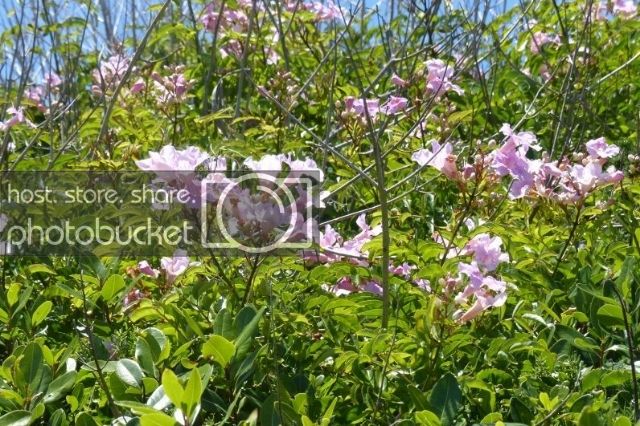 © arks
© arks
 © arks
© arks
 © arks
© arks
 © arks
© arks
Cape Peninsula, along the Kommetjie seaside boardwalk in late November
Description
Podranea ricasoliana is a vigorous, woody, scrambling, evergreen shrub without tendrils. The leaves are deep glossy green and compound, divided into oval, serrated leaflets. It sends up many tall strong stems, 3 to 10 m high, that have long spreading branches with an arching habit. Large bunches of fragrant lilac-pink, trumpet-shaped, foxglove-like flowers are produced all summer long (November to March). Leaves The flowers are carried at the branch tips of the new growth, and are held above the foliage. The flowers terminate a branch, and after flowering new side branches develop behind the spent flowers. The fruit is a long, narrow, straight, flattened capsule. The seeds are brown, ovate and flat, in a large rectangular papery wing. It tends not to produce many fertile seeds.
Distribution:
South African endemic to the Eastern Cape (Pondoland), it is found at the mouth of the Mzimvubu River at Port St Johns, roughly half way between East London and Durban on the Eastern Cape coast. It is a popular garden plant across the world.
Habitat
Coastal forest margins on shales.
Order: Laminales. Family: Bignoniaceae
 © arks
© arks © arks
© arks © arks
© arks © arks
© arksCape Peninsula, along the Kommetjie seaside boardwalk in late November
Description
Podranea ricasoliana is a vigorous, woody, scrambling, evergreen shrub without tendrils. The leaves are deep glossy green and compound, divided into oval, serrated leaflets. It sends up many tall strong stems, 3 to 10 m high, that have long spreading branches with an arching habit. Large bunches of fragrant lilac-pink, trumpet-shaped, foxglove-like flowers are produced all summer long (November to March). Leaves The flowers are carried at the branch tips of the new growth, and are held above the foliage. The flowers terminate a branch, and after flowering new side branches develop behind the spent flowers. The fruit is a long, narrow, straight, flattened capsule. The seeds are brown, ovate and flat, in a large rectangular papery wing. It tends not to produce many fertile seeds.
Distribution:
South African endemic to the Eastern Cape (Pondoland), it is found at the mouth of the Mzimvubu River at Port St Johns, roughly half way between East London and Durban on the Eastern Cape coast. It is a popular garden plant across the world.
Habitat
Coastal forest margins on shales.
Re: Africa Wild Tree & Shrub Book - Order Laminales
669. White Mangrove Avicennia marina (Witseebasboom)
Order: Lamiales. Family: Acanthaceae



uMlalazi Nature Reserve
Avicennia is a genus of flowering plants currently placed in the bear's breeches family, Acanthaceae. It contains mangrove trees, which occur in the intertidal zones of estuarine areas and are characterized by aerial roots.
The taxonomic placement of Avicennia is contentious. In some classifications it has been placed in the family Verbenaceae, but more recently has been placed by some botanists in the monogeneric family Avicenniaceae. Recent phylogenetic studies have suggested that Avicennia is derived from within Acanthaceae, and the genus is included in that family in the Angiosperm Phylogeny Group system.
Description
Small to medium-sized pale-stemmed tree (3–11 m), main trunk straight, up to 76 cm in diameter, with much branched, rounded crown. Bark pale yellowish green, with raised dots, flaking. Extensive underground root system with 'pencil roots' (pneumatophores or breathing roots) up to 90 mm long, sticking up out of the mud in dense stands spreading out from tree. Leaves olive-green above with dense, grey hairs below. Leaves opposite, 30–100 x 12–40 mm, thick, leathery, margin entire with sharply or bluntly pointed tip, base narrowing, petiole short (5 mm long). Flowers creamy yellow, small, in dense round heads in leaf axils or terminally, on short, square stalks, sweetly scented. Fruit a green, oval, two-valved capsule 20–25 mm diam.; seed developing on the tree, fruit usually splitting after falling; water-dispersed.
Distribution
White mangrove grows on the inland side of tropical and subtropical coastal swamps, along the east coast of Africa from about East London to Sudan (Red Sea coast), on the coasts of Arabia, India, northern Australia and on every island in the Indian Ocean.
Habitat
Estuaries and intertidal mud flaats. This species is found from downstream to intermediate estuarine zones in all intertidal regions. It is found at the mouth of rivers or in lower tidal areas.
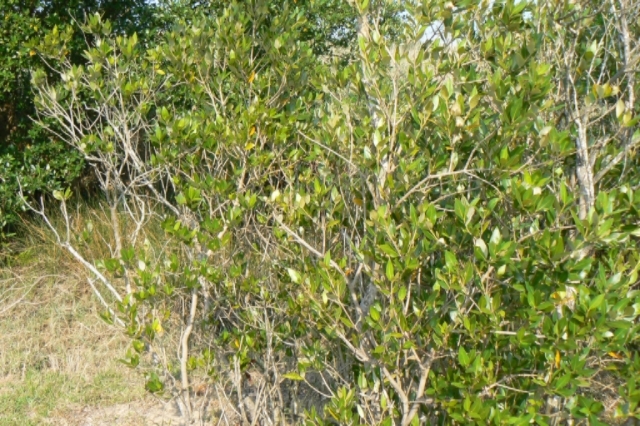
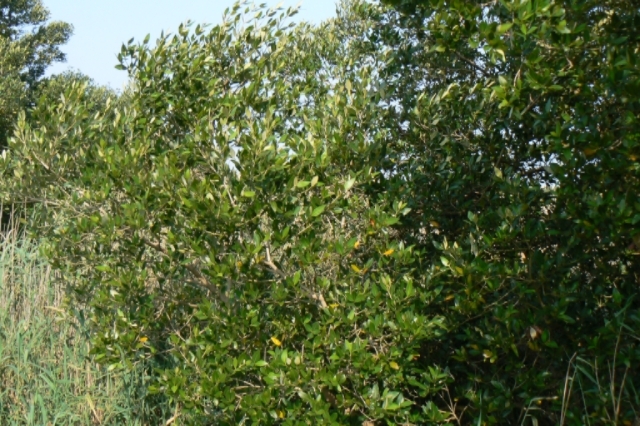

St. Lucia
Order: Lamiales. Family: Acanthaceae



uMlalazi Nature Reserve
Avicennia is a genus of flowering plants currently placed in the bear's breeches family, Acanthaceae. It contains mangrove trees, which occur in the intertidal zones of estuarine areas and are characterized by aerial roots.
The taxonomic placement of Avicennia is contentious. In some classifications it has been placed in the family Verbenaceae, but more recently has been placed by some botanists in the monogeneric family Avicenniaceae. Recent phylogenetic studies have suggested that Avicennia is derived from within Acanthaceae, and the genus is included in that family in the Angiosperm Phylogeny Group system.
Description
Small to medium-sized pale-stemmed tree (3–11 m), main trunk straight, up to 76 cm in diameter, with much branched, rounded crown. Bark pale yellowish green, with raised dots, flaking. Extensive underground root system with 'pencil roots' (pneumatophores or breathing roots) up to 90 mm long, sticking up out of the mud in dense stands spreading out from tree. Leaves olive-green above with dense, grey hairs below. Leaves opposite, 30–100 x 12–40 mm, thick, leathery, margin entire with sharply or bluntly pointed tip, base narrowing, petiole short (5 mm long). Flowers creamy yellow, small, in dense round heads in leaf axils or terminally, on short, square stalks, sweetly scented. Fruit a green, oval, two-valved capsule 20–25 mm diam.; seed developing on the tree, fruit usually splitting after falling; water-dispersed.
Distribution
White mangrove grows on the inland side of tropical and subtropical coastal swamps, along the east coast of Africa from about East London to Sudan (Red Sea coast), on the coasts of Arabia, India, northern Australia and on every island in the Indian Ocean.
Habitat
Estuaries and intertidal mud flaats. This species is found from downstream to intermediate estuarine zones in all intertidal regions. It is found at the mouth of rivers or in lower tidal areas.



St. Lucia
-
Klipspringer
- Global Moderator
- Posts: 5858
- Joined: Sat Sep 14, 2013 12:34 pm
- Country: Germany
- Contact:
Re: Africa Wild Tree & Shrub Book - Order Laminales
668. Southern Chinese Hats, Wild Parasol Flower Karomia speciosa (Sambreelboom)
Order: Lamiales. Family: Lamiaceae
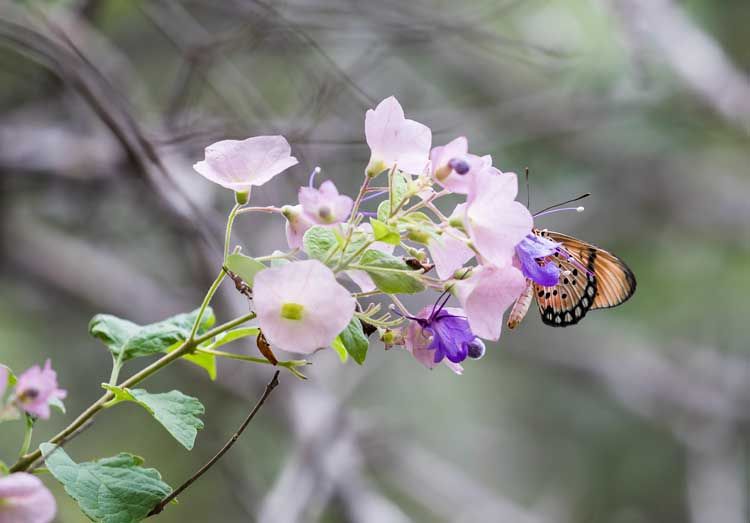 © Pumbaa
© Pumbaa
Kruger National Park, N’wanesti area
Description
A deciduous shrub or small tree ranging in height from 1- 6 m. It is a medium fast grower and is relatively long lived. The main stem is either single- or multi-stemmed, with finely striated branches of pale brown. (Striated: having narrow lines or grooves running more or less parallel). The bark, which is pale grayish-brown, is smooth.
The leaves, which occur opposite each other on the stem, are variable in shape ranging from oval and egg-shaped to oblong, meaning it is long and narrowly shaped. The margins of the leaves are roughly toothed and the colour is decidedly two-toned with an olive- or dark green above to a paler green below. The leaves are characterized by a soft texture with fine hairs occurring on both surfaces.
The flowers are produced in profusion near the ends of the branches, where they form small clusters from November to April. The flowers, which make this such an attractive shrub a must to have in a summer garden, are made up of two colours. The base of the flower, called the calyx, is a pink to mauve colour and often has a paper-like texture, while the main part of the flower is a deep blue to violet colour. It often happens that the main part of the flower falls off leaving the pink base behind, affording the plant a splash of colour long after the flowers have officially disappeared.
The fruit, produced between March and July, are carried in the persistent flower base (calyx). They are very small and rather inconspicuous, consisting of 4 lobes and a hairy surface.
Tree with fruits, Kruger National Park, © mposthumus
Distribution
Mozambique (Maputo province), Swaziland and South Africa (northernmost KwaZulu-Natal, Mpumalanaga and Limpopo).
Habitat
Bush or wooded areas on hot, dry, rocky slopes as well as in riverine thickets.
Links:
PlantZAfrica
Order: Lamiales. Family: Lamiaceae
 © Pumbaa
© PumbaaKruger National Park, N’wanesti area
Description
A deciduous shrub or small tree ranging in height from 1- 6 m. It is a medium fast grower and is relatively long lived. The main stem is either single- or multi-stemmed, with finely striated branches of pale brown. (Striated: having narrow lines or grooves running more or less parallel). The bark, which is pale grayish-brown, is smooth.
The leaves, which occur opposite each other on the stem, are variable in shape ranging from oval and egg-shaped to oblong, meaning it is long and narrowly shaped. The margins of the leaves are roughly toothed and the colour is decidedly two-toned with an olive- or dark green above to a paler green below. The leaves are characterized by a soft texture with fine hairs occurring on both surfaces.
The flowers are produced in profusion near the ends of the branches, where they form small clusters from November to April. The flowers, which make this such an attractive shrub a must to have in a summer garden, are made up of two colours. The base of the flower, called the calyx, is a pink to mauve colour and often has a paper-like texture, while the main part of the flower is a deep blue to violet colour. It often happens that the main part of the flower falls off leaving the pink base behind, affording the plant a splash of colour long after the flowers have officially disappeared.
The fruit, produced between March and July, are carried in the persistent flower base (calyx). They are very small and rather inconspicuous, consisting of 4 lobes and a hairy surface.
Tree with fruits, Kruger National Park, © mposthumus
Distribution
Mozambique (Maputo province), Swaziland and South Africa (northernmost KwaZulu-Natal, Mpumalanaga and Limpopo).
Habitat
Bush or wooded areas on hot, dry, rocky slopes as well as in riverine thickets.
Links:
PlantZAfrica


